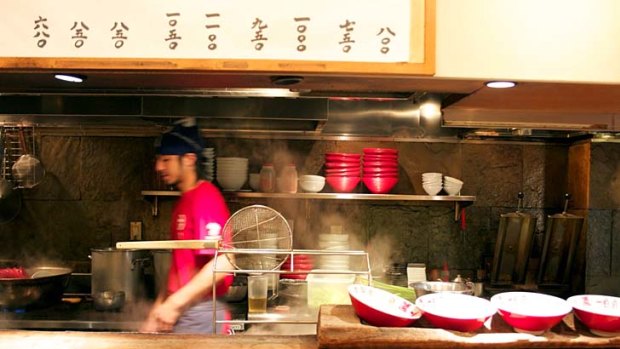
On the move ... a Tokyo noodle bar.Credit: Kate Gibbs
SPECIAL PROMOTION
From footpath cooks to alcoves, bars and nooks, here's where Tokyo insiders stop for delicious, inexpensive meals, writes Kate Gibbs.
Tokyo's neon-lit alleys are packed with food carts and hole-in-the-wall haunts where queues of in-the-know locals and visitors seek ramen, soba, yakitori and tako-yaki. In a city known for its Michelin-star options and with 160,000 eateries - four times the number of Paris - street vendors win loyal customers by satisfying the desire to eat quickly, well and inexpensively.
"People in Japan are very particular, they are perfectionists," says Kazuki Watanabe, who manages an elegant izakaya-style restaurant called Higashi-Yama in Meguro-ku. "This includes eating the best possible food, no matter if it is bought by the side of the road."
Golf-ball size tako-yaki filled with tender octopus is the mainstay of food-on-the-run. Typically cooked in cast-iron custom-made pans by the roadside, the balls have a crisp exterior, are drizzled in a syrupy sweet and salty sauce, then mayonnaise, and topped with smoky, delicate shaved bonito fish flakes.
Some of the best food in Tokyo is found near or within train stations, as people like to eat before they commute home. Outside Shibuya Station, for example, a popular nook called Gindaco serves eight balls of tako-yaki for ¥500 yen (about $6).
Kerbside eating can involve ceremony, too. It's not uncommon to place an order by buying a meal ticket from a vending machine by the front door of a tiny bar and walk through two squares of fabric into a place that has served the same secret ramen recipe for the past 150 years.
Glutinous rice balls spiked on to a stick and grilled with a sweet cloying sauce are often served outside temples and train stations. Odango-ya is sweet and one of the best-value street foods in the city.
Another Japanese staple, yakitori (chicken on a stick) covers a wide margin of quality and type. Bird Land, which rules the yakitori coop in terms of sheer variety of chicken parts served, is a basement bar in Ginza. Quality skewered chicken gizzards, skin, liver, necks, hearts and breast, glazed and grilled over charcoal, are also found at Souten in Minami-Ootsuka.
Outside the massive Tsukiji fish market, open-air nooks dish up fried food, sauce-splashed bowls of noodle, meaty stews and pickle-flecked rice. From early morning, locals arrive for some of the best fast food in town and the queues here say it all. Two hole-in-the-wall sushi experts inside Tsukiji compete for the title of best breakfast of champions. Neighbouring stands Sushi Dai and Daiwa Sushi both do set menus of glistening fish on rice, from o-toro and chu-toro (fatty tuna) to squid, mackerel and shellfish so fresh it's still writhing when topped with pickled ginger. In winter, when salmon roe is in season, ikura nigiri is so fresh that eating a mouthful is like being splashed in the face with cold sea water.
However, the most popular and arguably best street food in Tokyo remains ramen: rich pork broth with noodles, a thin slab of roast fatty pork, shredded crunchy fungi and fermented bamboo shoots and, perhaps, a soy-flavoured, half egg. Chain stalls and shops have cropped up across the city, filled with commuters paying about ¥800 for a bowl. When the slurping stops and the bowl is empty, an army of locals swings back into the street.
FAST FACTS
Eating there
Tako-yaki: The Gindaco chain specialises in serving tako-yaki. In Shibuya, under the overpass near Shibuya Station, order from Gindaco's street-side window.
Yakitori: Bird Land is open 5pm-9pm, closed Sundays and Mondays. Reservations recommended. (Tsukamoto-Building B1F, 4-2-15 Ginza Chuo-ku. Phone +81 3 5250 1081; see ginza-birdland.sakura.ne.jp)
Souten is a short walk from JR Ootsuka Station. Follow the old streetcar line past tiny traditional stores to find this alcove. (3-39-13 Minami-Otsuka, Toshima-ku. Phone +81 3 5944 8105).
Aoyama Farmers' Markets: Saturday and Sunday, every weekend. Outside the United Nations University, 10am to 4pm, Jingumae 5-53-70, Shibuya. You'll find Western-style food trucks here at weekends, too.
Coffee: Cafe-on-wheels Madeleine is available on the Meguro River in hip Nakemeguro most afternoons from 2pm. The barista sits in the back seat of a cream-coloured Citroen 2CV serving espresso-brewed cappuccino (about ¥320 a cup) and a creamy green-tea latte mix called uji matcha. (Head for Cow Books, 1-14-11 Aobadai Meguro. The Citroen is usually parked nearby).
This series of articles sponsored by the Japan National Tourism Organisation.
Sign up for the Traveller Deals newsletter
Get exclusive travel deals delivered straight to your inbox. Sign up now.